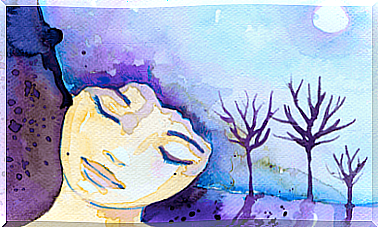Delayed Mourning, When Suffering Becomes Chronic

Delayed, or frozen, bereavement refers to a loss that has not been overcome. It is pain that becomes chronic, that creeps in permanently and manifests itself in different ways: anxiety, stress, fatigue, apathy, constant irritation … As surprising as it may seem, it is a very frequent clinical reality.
Some people don’t know how to manage pain, that suffering that paralyzes and creates a void that is difficult to fill. Others cling to daily life, work, and commitments by convincing themselves that they can move on. They tell themselves that everything is fine, that the pain can be hidden; like someone who secures a personal item.
Both of these groups of people share the same anatomy of suffering : that of pathological pain, in which there is no closure or acceptance of loss. It is good to understand that pain has no expiration date, it can last for decades and affect everything you think and do. The delayed mourning hides behind multiple diseases and obscures the possibility of being happy again.

What is delayed bereavement?
Mourning can be frozen, it can be paused or even trapped, like a seed in a drop of amber. It happens when we refuse to face a painful reality, when we repeat to ourselves that it is better to put it aside to resume our life without thinking about the loss of a loved one.
A situation that bereavement specialists know very well, that is, this psychological process is experienced very differently depending on the person. Well, it is common opinion that a loss is synonymous with sadness and that, on average, it takes between a year and a year and a half to overcome it and mourn.
But these ideas are not entirely correct. First, when you lose a loved one, you experience a feeling that goes beyond sadness. A mixture of anger, confusion and even anguish. Furthermore, the experience of bereavement is directly linked to the personality of each individual, to the resources and to the social and personal support available at that given moment.
As explained in the study conducted by Dr. Katherine Shear, of Columbia University in New York, it is extremely difficult to predict how a person will cope with the loss of a loved one. It is also estimated that about 5% of the population will experience a delayed mourning episode sooner or later. Let’s see the characteristics of this process below.
Symptoms of delayed bereavement
Delayed bereavement is a defense mechanism. The person refuses to accept what has happened, fails to face reality, does not feel able to face this suffering. The brain, therefore, chooses to deny or simply “freeze” suffering by putting it aside.
Well, this psychological strain and emotional containment have consequences:
- Anxiety and Stress Disorders.
- Hypersensitivity. Any unforeseen or fortuitous event is experienced in an oversized way.
- Eating disorders or addictive behaviors.
- Peremptory refusal to name and talk about the loss of a loved one.
- Appearance of psychosomatic symptoms, such as digestive problems, allergies, headaches, body aches, skin problems, hair loss.
- Lack of vision and planning for the future. Stop having life plans and goals.
- Problems at the relational level. Lack of joy, patience, desire to share or enjoy moments of leisure. Relating to others in an unauthentic way. Loss of empathy due to unaccepted inner suffering that obscures everything else.
How is delayed bereavement treated?
Those who experience delayed bereavement should know that eventually all of the emotional charge will re-emerge. Sometimes it doesn’t take much to trigger a series of sensations capable of overflowing. The death of a pet, witnessing the illness of a loved one, or even a minor accident can trigger a flood of feelings that are difficult to manage.
In the Diagnostic and Statistical Manual of Mental Disorders (DSM-5), the clinical conditions of frozen mourning do not appear as such. However, there are diagnostic criteria for “complicated persistent bereavement disorder”. Well, in consideration of the existence of this pathological bereavement, in recent years new therapies have been developed which are proving to be very effective.
We find an example of this in the 2012 study by Dr. Julie Wetherell of the University of San Diego, California. It is an approach that combines cognitive behavioral therapy and interpersonal therapy with prolonged exposure techniques. The basic purpose is to encourage the acceptance of loss, work on emotions and on another often present aspect: the sense of guilt.

Conclusions
No one is prepared for a loss. Mourning is not a universal process, much less a regulated one; it can be dynamic, rigid, complex and even pathological. Asking for help (and being helped) is extremely useful in facing this new reality in an adequate and healthy way.









